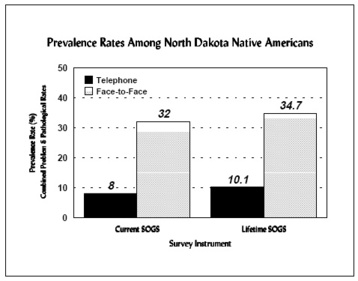The WAGER, Vol. 2(10) – Face-to-face interviewing & telephone surveys: The meaning of different rates
Researchers have long debated which instrument most accurately measures the occurrence of problem gambling. Less attention has been paid to which interview method yields the most valid estimate. A recent study surveyed 400 Native Americans residing in the four counties in North Dakota having the greatest proportion of Native Americans.* The researchers surveyed both a telephone sample and a face-to-face household sample to avoid bias resulting from sampling only households with telephones. This study found that the prevalence rates of problem gambling varied depending on the method of interview (telephone or face-to-face). The combined current prevalence rate (pathological & problem) among respondents interviewed by telephone was 8%, while the rate among respondents interviewed face-to-face was 32%. A similar pattern was observed with lifetime rates. The respondents interviewed in person were significantly more likely than respondents interviewed by telephone to be under 30 years old and to have a household income of less than $25,000. Factors of age and income are likely to be associated with not having a telephone. These factors also may be related to problem gambling (e.g., telephone service cut off due to unpaid bills as a result of gambling debt). If this is the case, studies utilizing telephone surveys may produce underestimates of problem gambling rates, and face-toface interviews may yield overestimates. Alternatively, if these different rates controlled for age and income, the difference in the rates of problem gambling might disappear. New research is necessary to resolve this issue. For example, it is important to determine if face-to-face interviews with telephone-owning individuals yield rates comparable to telephone interviews with telephone-owning individuals.

Sources adapted from: *Volberg, R.A., & Precision Marketing, Inc. (1993). Gambling and problem gambling among Native Americans in North Dakota. (Report to the North Dakota Department of Human Services, Division of Mental Health). Albany, NY: Gemini Research.
This public education project is funded, in part, by The Andrews Foundation.